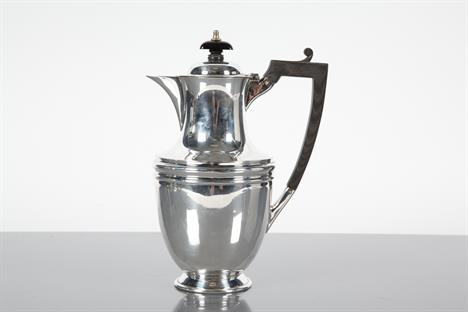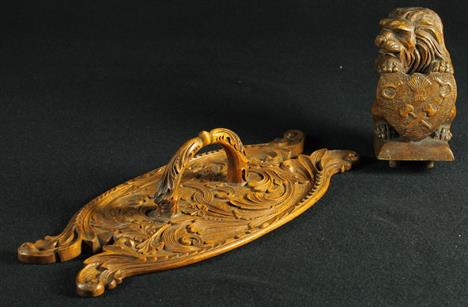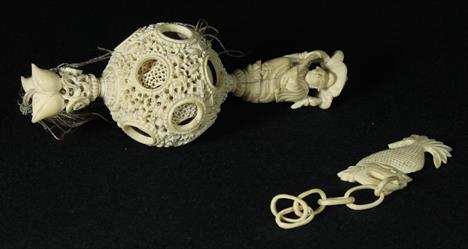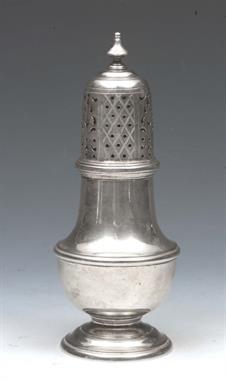We found 116099 price guide item(s) matching your search
There are 116099 lots that match your search criteria. Subscribe now to get instant access to the full price guide service.
Click here to subscribe- List
- Grid
-
116099 item(s)/page
A French Louis XVI style gilt brass mounted Siena marble mantel clock garniture Hanteau, Alencon, circa 1900 The eight-day bell striking movement stamped S.H. PARIS to backplate and with blue on white enamel Arabic numeral dial signed HANTEAU ALENCON to centre, with fine pierced and chased gilt scroll hands within engine-turned bevel glazed bezel, the case with eagle and scroll cast surmount to the circular drum flanked by ovoid finials set onto horizontal platforms supported by panel uprights fronted with laurel wreath and stylised foliate scroll cast mounts with sunburst pendulum swinging between, on demi-lune fronted skirt base with conforming mount to apron and disc feet, 31cm (12.25ins) high; with a pair of urn side pieces en-suite, each with flambeau cast finial above triform lions mask capped supports and circular base with conforming disc feet, 25.5cm (10ins) high; and a group of three giltwood stands (non-original to clock garniture).
A Queen Anne style walnut mercury pillar barometer Unsigned, in the manner of Daniel Quare, probably early 20th century The rectangular glazed two-piece silvered scale divided for barometric inches and annotated with summer and winter observations beneath comment Fair if Rise, Foul if Fall to upper margin, the top with brass finial-shaped recording pointer adjustment screws above tube concealed within Doric column-turned upright with cavetto moulded upstand to capital and brass collars to the spiral fluted lower section of the shaft, the base with moulded cylindrical cistern incorporating pendant finial for level adjustment to underside, 99cm (39ins) high.
A Queen Anne style brass mounted walnut mercury pillar barometer Unsigned, in the manner of Daniel Quare, early 20th century The rectangular engraved brass superstructure enclosing two-piece silvered scale divided for barometric inches and annotated with summer and winter observations beneath grotesque mask engraved caddy flanked by brass finial-shaped recording pointer adjustment screws, above floral decorated rectangular panel to throat and tube concealed within Doric column-turned upright with cavetto moulded upstand to capital and brass collars to the spiral fluted lower section of the shaft, the base with moulded cylindrical cistern, 92cm (36.25ins) high; with a large alcohol Fahrenheit scale thermometer, recent, with arched brass plate in arch-glazed mahogany case with cavetto moulded base, 61.5cm (24.25ins) high, (2).
A French Louis XV style gilt brass miniature mantel timepiece Unsigned, late 19th century The eight-day back wound movement with silvered platform cylinder escapement and stamped 484 to backplate, the circular white enamel Roman numeral dial with polychrome floral garland decoration to centre and Arabic five minutes to outer track, the waisted case with urn finial above symmetrical front finely chased with floral sprays within sculpted scroll borders, the sides similarly decorated with panels incorporating foliate trails, the rear with shuttered winding holes within a diamond hatched field, on generous scroll cast supports, (minute hand and glass lacking), 19cm (7.5ins) high.
A George III brass mounted ebonised small table clock case Unsigned, late 18th century, the movement and dial later The current French eight-day bell striking movement with Brocot type pendulum suspension and stamped 968 to backplate, the 4 inch circular convex white enamel Roman numeral dial with blued steel hands and red Arabic numeral quarter hours within outer minute track, now fitted to the earlier brass mounted ebonised bell-top case with pineapple finial above radial gadroon cast cornice moulding and front door with convex bevel glazed brass bezel over shaped cast bead bordered panel to apron flanked by inset mouldings to angles, the sides with brass fillet bordered arched glazed apertures, on skirt base with foliate trail cast moulding and leaf decorated bracket feet, 27cm (10.5ins) high excluding finial, 32cm (12.5ins) high overall.
A William III burr walnut eight-day longcase clock Joseph Windmills, London, circa 1695 The six finned and latched pillar rack and bell striking movement with anchor escapement and 11 inch square brass dial with subsidiary seconds dial, ringed winding holes and calendar aperture to the matted centre within applied silvered Roman numeral chapter ring with stylised sword hilt half hour markers, Arabic five minutes to outer track and signed J: Windmills, London to lower edge, the angles with gilt twin cherub and crown cast spandrels with foliate engraved infill between, in a case with gilt ball finials to the domed caddy upstand above moulded cornice, fine foliate pierced frets to frieze and generous three-quarter columns with gilt caps and bases flanking dial aperture, the sides with rectangular windows and rear quarter columns each set against bargeboard rising up the underside of the cornice projection, the trunk with convex throat moulding and 41 inch book matched veneered door, the sides divided into pairs of panels with line borders, on crossbanded plinth base with bun feet (case probably with restoration) 214cm (7ft) high excluding top finial, 222cm (87.5ins) high overall. The life and work of Joseph Windmills and his successors is comprehensively documented in Neale, J.A. Joseph and Thomas Windmills Clock and Watch Makers 1671-1737. Joseph joined the Clockmakers` Company as a free Brother in on 29th September 1671 - the same year that Joseph Knibb, Daniel Quare and Thomas Tompion also gained their freedom of the Company. He initially worked from Blow Bladder Street in St. Martins le Grand, London before moving to premises at Swan Court, Mark Lane End, next Tower Street by April 1674 where the business remained. Joseph took his son, Thomas, as an apprentice who, after gaining his freedom in 1696, is thought to have immediately gone into business with his father; by 1700 the firm had become a partnership which lasted until Joseph`s death in 1724. As a contemporary of Knibb, Quare and Tompion Joseph Windmills would have had to compete with some of the finest clockmakers that have ever lived during a period of heightened scientific enlightenment. In this environment Windmills excelled, producing clocks of a quality that equalled many of his more famous peers. The current lot is no exception as the movement is very well made with no less than six finely turned and latched pillars, the underdial lever work for the rack strike is also fully cocked (rather than pivoted on steel posts alone). The dial is typical of Windmills at this period with the winding holes, calendar aperture and centre of the seconds dial having ring-turned decoration, and the chapter ring utilises his preferred form of stylised sword hilt half marker. A slightly later clock with almost identical movement and dial is illustrated in Neale A.J. Joseph and Thomas Windmills.., page 123 (fig. 5.3). The case is also of fine quality with richly figured veneers and `Tompionesque` proportions. The current lot is in has been consigned in fine presentable working order however the case has probably had some well executed conservation work undertaken in the past.
A fine George III brass mounted mahogany quarter-chiming table clock with enamel dials Herman Diedrich Sporing, London circa 1765 The seven pillar triple fusee movement with rise/fall regulation to the verge escapement, chiming the quarters on a nest of six graduated bells and striking the hour on a further larger bell, the backplate engraved with delicate asymmetric foliate scrolls with pendulum holdfast hook to lower left hand corner, the 7 inch brass break-arch dial plate with applied circular convex white enamel dial signed HERMAN DIEDRICH SPORING, LONDON to centre and with Arabic five minutes to outer track, the angles with rococo scroll cast spandrels beneath arch with two conforming subsidiary enamel dials for Strike/Silent selection and regulation within delicate foliate scroll engraved field, the bell top case with pedestal surmount capped with a pineapple finial above brass collar and four further finials to superstructure, over front with scroll cast upper quadrant frets and fillet inset glazed dial aperture to door flanked by cast female caryatid applied canted angles, the sides with generous hinged carrying handles above conforming concave topped rectangular side windows, on moulded shallow skirt base with foliate scroll cast bracket feet, 46cm (18ins) high excluding top finial and pedestal, 56cm (22ins) high overall. Herman Diedrich Sporing was Finnish by birth and was one of the `four gentlemen of the faculty` employed by Joseph Banks to accompany Captain James Cook (then Lieutenant) on his first voyage on H.M.S. Endeavour 1768-71. Born in Turko, Finland, 1733 Herman Diedrich Sporing was initially destined to follow his father (of the same name) by studying to become a physician at Turku University (where his father was Professor), before going onto Stockholm to continue his training. Whilst in Stockholm Sporing decided to go to sea (1755) which lead him to settle in London where he trained as a watch and instrument maker (although it appears that he never gained his freedom of the Clockmakers` Company). It was at this time that he befriended Dr. Daniel Solander, a Swede of the same age who also had medical training, who in turn introduced Sporing to Joseph Banks. It was through Banks that both Solander and Sporing were enlisted on H.M.S. Endeavour, with Sporing taking the position of Assistant Naturalist to Banks. The primary official purpose of Cook`s voyage was to ensure that the astronomer, Charles Green, was able to undertake observations of the transit of Venus from Tahiti which was due to take place on 3rd June 1769. The Endeavour landed at Tahiti in plenty of time allowing Lieutenant Cook to construct `Fort Venus`, an elaborate fortified structure from which the observations can be made. Unfortunately, shortly before the event was due to take place, the astronomical quadrant (supplied by Bird) was stolen by local islanders and disassembled. Fortunately all of the parts were recovered by the party of men sent out charged with the task and Sporing (as a trained watch and instrument maker) reassembled the instrument. On the day of the transit Sporing was detailed along with Dr. Jonathan Monkhouse to accompany Lieutenant Gore and Banks to proceed to nearby York Island (Moorea) where Sporing and Monkhouse were to undertake secondary observations. Lieutenant James Cook, a trained astronomer in his own right, clearly found Sporing to be useful at this time; no doubt his abilities as a watch and instrument maker were also crucial to his purpose, as the inventory of instruments was extensive and included a portable longcase regulator by John Shelton. The observation data gathered was eventually transferred to the Admiralty for dispatch to the Astronomer Royal Neville Maskelyne (during the ill-fated stop-off at Batavia on the return leg of the voyage). This data, along with other observations of the same event taken around the globe, were used by Thomas Hornsby to calculate a fairly accurate approximation of the distance of the Earth from the Sun. After the observations had taken place Lieutenant Cook opened sealed orders from the Admiralty which instructed him to seek the position of the great Southern Continent. Charged with these instructions H.M.S. Endeavour proceeded to eventually find New Zealand. During the seven month circumnavigation of the islands Sporing`s primary role was to produce drawn records of fauna and flora (most of the surviving drawings are now held in the British Museum). On the 2nd November 1769 the Endeavour was assaulted by Maori war canoes whilst off Motuhora Island (Whale Island). During this attack Sporing drew details of the canoes and the Maori`s themselves, these drawings along with those of the previous month depicting the arched rock at Tolaga Bay are the earliest images of Maori culture recorded by a Westerner. In recognition of Sporing`s efforts Lieutenant Cook named a small island after him (in Tolaga bay near present day Gisborne) which has now quite rightly reverted back to its Maori name `Pourewa`. Leaving New Zealand H.M.S Endeavour proceeded onto Australia with the `first landing` at Botany Bay taking place on 29th April 1770. During the eight-days spent at Botany Bay Sporing was extremely busy recording the overwhelming quantity of new fauna and flora. Perhaps the best known of Sporing`s drawings from Botany Bay are those of a stingray and banjo shark which were observed from fresh specimens. From Botany Bay Cook headed northwards, up the Eastern Coast of Australia, until H.M.S. Endeavour was seriously holed on the Great Barrier Reef. The vessel was skilfully beached by Cook for repairs near a small river outlet, now called The Endeavour River, near modern day Cooktown in Queensland. It was during these two months of being laid-up that the first kangaroos were seen; on the 14th July one was shot by Lieutenant Gore and examined by Sporing and his fellow Naturalists. Once the vessel had been successfully refloated Cook proceeded (beyond the Great Barrier Reef) northwards until he eventually landed at Batavia on 10th October 1770. By this time H.M.S Endeavour was somewhat worse for wear so was docked for repairs. By 7th December she was ready to depart for the home leg of the voyage and left on Christmas Day 1770 bound for the Cape of Good Hope. Unfortunately whilst at Batavia the crew had been exposed to disease, such as malaria and dysentery, which resulted in disastrous outbreaks. No less than 26 members of the crew succumbed, with Banks, Solander, Green and Sporing also falling ill. Herman Diedrich Sporing died at sea on 24th January 1771 with the astronomer Charles Green dying five days later. When H.M.S. Endeavour finally landed off Deal on 12th July 1771 she had been absent for three years and had lost 38 eight from her compliment of 100 men. The current lot can be fairly accurately dated between circa 1760 and 1768 as it would have been made during Sporing`s time in London after he had undergone training as a Watch and Instrument maker. The dial, with its applied enamel centre beneath twin subsidiaries, echoes the work of Justin Vulliamy and can be closely compared to an example by him illustrated in Barder, Richard C.R. The Georgian Bracket Clock 1714-1830 on page 138 (colour plate 18). As the current lot is believed to have (up until recently) spent all its life in Sweden, it is probable that Herman Diedrich Sporing supplied it direct to a client in his home country of Finland - possibly his own family. This historically interesting and apparently unique clock has survived in fine unrestored condition and requires only gentle conservation to bring it back to full original working condition.
An impressive George III green chinoiserie japanned quarter-chiming table clock Thomas Eastland, London, mid 18th century The substantial six pillar triple fusee movement with verge escapement, chiming the quarters on a graduated nest of eight-bells and striking the hour on a further larger bell, the symmetrical foliate scroll and strapwork engraved backplate signed Tho:s Eastland, London to centre, the 7.5 inch brass break-arch dial with calendar and false-bob aperture signed Tho Eastland London to the matted centre within applied Roman numeral chapter ring with Arabic five minutes and unusual fine foliate cast and pierced gilt spandrels to angles beneath arch with subsidiary Strike/Silent selection dial flanked by conforming mounts, the elaborate case with gilt pineapple finial to the bell-top upstand decorated in raised polychrome and gilt with oriental figures conversing above gilt blind fret infill and four further finials to the break-arch cornice, the front with figural panels within trellis borders to door surround flanked by finely cast and chased bare-breasted female terms with fabric drapery and scroll terminals issuing inverted floral sprays to the canted angles, the sides with brass handles over concave-topped rectangular windows, the rear matching the front, on floral panel centred gilt trellis decorated concave moulded skirt base incorporating shaped apron and bracket feet, 58.5cm (23ins) high excluding top finial; 63.5cm (25ins) high overall. Thomas Eastland is recorded in Baillie, G.H. Watchmakers & Clockmakers of the World as working in London 1744-51.
EDWARDIAN SILVER THREE PIECE TEA SERVICE comprising a teapot, sugar and cream, of rectangular form and raised on four ball feet, each rim with shell and gadrooned cast patterns, the teapot with an ebonised finial and handle, Birmingham 1906, approximately 853g Hallmarks partially rubbed, small dent to the body of the teapot
FINE SILVER ART DECO FOUR PIECE TEA SERVICE comprising tea pot, water pot, sugar and cream, and a pair of later silver sugar tongs, the teapot and water pot with ivory finial and handle, each of circular form and with a stepped foot, makers Adie Brothers, Birmingham 1935/35, the sugar tongs Sheffield 1936, approximately 1855g in total The sugar bowl with a small dent to one side. Each with light surface marks.
GEORGE V SILVER CONDIMENT SET comprising a salt and pepper shaker, two salt dishes and a mustard pot with one spoon, with blue glass liners, Birmingham 1923/1924, approximately 230g overall, in a fitted case Hallmarks partially rubbed to salt dishes. The wavy rims to the salt and pepper and the mustard are slightly misshapen. Part loss to one of the upturned feet of the salt shaker, and the finial is slightly bent to one side. Missing two condiment spoons.
VICTORIAN SILVER FOUR PIECE TEA SERVICE comprising a teapot, water pot, sugar and cream, each with a border of classical figurative designs including warriors, chariots and winged goddess, the teapot and water pot each with a helmet finial to the hinged cover, maker Martin Hall & Co, London 1872, approximately 2424g in total Tea teapot handle has a tiny dent, otherwise no damages, the marks are clear on the jug and water pot, the sugar bowl maker`s stamp is rubbed, the teapot marks are slightly rubbed
GEORGE V SILVER FOUR PIECE TEA SERVICE comprising a teapot, water pot, sugar and cream, each of oval form, the pierced borders with scrolling foliate decoration, the teapot and jug with an ebonised finial and handle, each on four cabriole legs, maker JDWD, Sheffield 1927, approximately 2188g in total The water pot, sugar and cream all with dents to the body, all over light surface wear, marks are slightly rubbed but legible
SILVER PEPPER POT, SUGAR BOWL AND A CASTER the pepper pot of baluster shape with flame finial, Birmingham marks, approximately 140g, 12cm high; the bowl with twin loop handles, Birmingham marks, approximately 124g, 15cm wide; the caster embossed with foliate designs, the top section with twisting open/close mechanism, Birmingham marks, approximately 137g, 11.5cm high (3) The bowl has a slightly misshapen foot, clear hallmarks to each piece; the caster with presentation inscription to the base rim
SILVER THREE PIECE TEA SERVICE comprising a teapot, sugar and cream, each of circular form, the teapot with wooden handle and finial to the hinged cover, London marks, approximately 941g in total The marks on the teapot and jug are quite indistinct through rubbing, minor surface scratches, the cream jug has a small dent as has the teapot lid
SCOTTISH SILVER FOUR PIECE TEA SERVICE comprising a teapot, water pot, sugar and cream, each of circular form, the teapot with wooden handle and finial to the hinged cover, maker J.W, Glasgow 1928, approximately 1041g in total Overall very nice condition, the teapot has one very small pinhead dent just under the hallmarks
SILVER TEAPOT, SMALLER SILVER TEAPOT AND A SILVER CREAM JUG of oval form, with an ebonised finial and handle, Chester marks; together with a smaller partly gadrooned teapot, Chester marks, and a faceted cream jug, Birmingham marks, approximately 897g in total The rectangular teapot has rubbed marks and several small dents; the oval teapot has clearer marks though the maker`s mark is indistinct; the sauce boat is undamaged with clear marks
A fine old Oak and Mahogany cased eight day Longcase Clock having a painted 14'' square face with foliage floral details to the corners, Arabic numerals, inset date register dial and shaped moon phase window revealing maritime and windmill scenes, the maker ''T. Gaskill, Knutsford'' (T. Gaskell), the scroll pediment hood with a spherical finial and reeded pillars to either side, the body of the case with reeded quarter mouldings, the door having contrasting banding, standing on bracket feet, 95'' high approx.
An early Victorian walnut duet stand, circa 1840, central brass stem with stylised acorn finial, above a pair of profusely acanthus decorated and pierced rests, turned stem with lotus terminal, flanked by S-scroll brackets, concave sided plinth, on scroll carved feet, ceramic castors, 135cm high (unextended), 42cm wide
A Victorian amboyna ebonised and gilt metal mounted circular occasional table, circa 1890, circular top, frieze incorporating marquetry anthemion and flowerhead motifs, three turned supports centred by a finial, downswept legs, brass caps and ceramic castors, 69cm high, the top 70cm diameter
A stone composition garden urn, 20th century, of Campana form, with flared rim, lobed and waisted body, waisted socle and square base, 85cm high, 65cm diameter; another stone composition urn, 20th century, of shallow form, 36cm high, 76cm diameter, and a stone composition garden lantern, 20th century, the domed top with finial above six scrolled acroteria, the hexagonal lantern on a cylindrical stem, 132cm high
A George III style mahogany Pole Screen, embroidered with flowers around a plain rectangular mirror glass all within an arch top frame, attached to a turned tapering pole support, surmounted by a turned finial and raised on a tripartite base with scroll legs terminating in claw and ball feet, 190cm high
1930s three piece silver teaset comprising teapot of circular form with bead rim, scroll handle, domed hinged cover with turned finial, on circular pedestal foot with beaded border, matching sugar and cream (Birmingham 1932), maker - S Ltd. All at approximately 21ozs, teapot 14.5cm diameter
Vienna ebonised wall clock, 19th century, the white Roman dial with subsidiary seconds, on a single weight momvement with ebonised pendulum rod and brass lenticle, the case with set out turned columns surmounted by a turned finial, length 110cm. *See clocks and watches proviso. Condition report: see terms and conditions.
-
116099 item(s)/page



























































